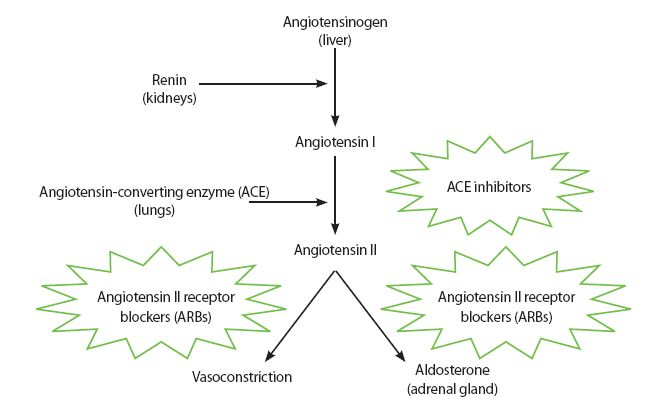
Chronic kidney disease CKD affects an estimated 1 to 3 of all cats and 05 to 15 of all dogs. Enalapril also increases blood flow to the kidneys which may be helpful for some dogs that are experiencing kidney disease.

Enalapril dilates a structure in the kidney that carries blood away from the glomeruli and reduces its filtration rate and prevents protein proteinuria and blood leaking in the urine.
Enalapril for dogs kidney. Enalapril for Chronic Kidney Failure in Dogs. By inhibiting angiotensin II Enalapril decreases the renal-filtration pressure or basically lowers the workload on the kidneys. This feature can be used to manage dogs with glomerulonephritis and chronic kidney failure.
Enalapril for Protein-Losing Nephropathies in Dogs. Enalapril dilates a structure in the kidney that carries blood away from the glomeruli and reduces its filtration rate and prevents protein proteinuria and blood leaking in the urine. Side Effects of Enalapril for Dogs.
Whether different ACE-inhibitors have distinct kidney protective effects is unknown. It is therefore hypothesized that renal diets and enalapril or benazepril have different beneficial effects in proteinuric CKD dogs. Forty-four dogs with proteinuric CKD IRIS stages 1-4 were enrolled in the study and were fed renal diet for 30 days.
Treating proteinuria in dogs reduces the progression of chronic kidney disease CKD. Renal diets and angiotensin-converting enzyme ACE-inhibitors are cornerstones of treatment. Whether different ACE-inhibitors have distinct kidney protective effects is unknown.
It is therefore hypothesized that renal diets and enalapril or benazepril have different beneficial effects in. Enalapril is used on and off label and is given by mouth or injection to treat heart failure high blood pressure chronic kidney disease or proteinuria. Common side effects include loss of appetite vomiting diarrhea and tiredness.
Do not use in pets that are allergic to it have an acute kidney injury or have certain heart conditions. Enalapril for dogs is also used to treat heart murmurs chronic kidney failure and other heart and blood disorders. It is also sometimes used to treat very high blood pressure due to its ability to relax the blood vessels.
The bioavailability of the pro-drugs benazepril and enalapril in dogs ranges from 20 to 40. Elimination routes differ between ACE inhibitors. For example in dogs enalaprilat is mainly cleared 95 by the kidney while benazeprilat is cleared by.
Enalapril also increases blood flow to the kidneys which may be helpful for some dogs that are experiencing kidney disease. It is also believed that enalapril and other ACE inhibitors probably decrease the amount of useable protein that is allowed to escape through the kidneys and into the urine. Initial effect of enalapril on kidney function in patients with moderate to severe chronic nephropathy.
Angiotensin converting enzyme ACE inhibitors has been suggested to halt the progression of chronic renal failure. As the initial step of a controlled trial of this hypothesis it was investigated whether start of enalapril in patients with. Enalapril is a commonly used drug used to cure heart and kidney diseases in dogs.
It is also frequently used to cure other heart related problems such as high blood pressure or hypertension. This drug cannot be purchased without a prescription from the vet and sometimes may be available for purchase only through the vets office. Enalapril can treat mild to severe heart failure and high blood pressure in dogs.
It can also treat heart murmurs chronic kidney failure and other heart and blood illnesses. By lowering blood pressure the drug helps the heart beat more efficiently and prevents fluid from building up in the lungs improving exercise tolerance. It is uncommon for dogs to develop significant worsening azotaemia due to decreased renal blood flow due to the reduced pressure 30 increase in creatinine although caution is recommended using the drug in dogs with IRIS stage IV renal failure.
Even though enalapril is excreted only though the kidneys vs. Benazepril which also has biliary excretion route there is. Chronic kidney disease CKD affects an estimated 1 to 3 of all cats and 05 to 15 of all dogs.
1 Nephron damage associated with CKD is usually irreversible and can be progressive Figure 1CKD is a major cause of morbidity and mortality especially in older dogs and cats. Excessive phosphorus intake and inappropriately high serum phosphorus concentrations appear to promote progressive kidney injury46 Intervention is indicated in dogs and cats with chronic kidney disease stages 2 through 4 when the phosphorus concentrations rise above stage-specific therapeutic target concentrations. Enalapril maleate for dogs is an effective drug that treats heart failure high blood pressure and sometimes kidney disease.
Like any drug it can create unwanted side effects. Most are minor and temporary but its important to recognize and act on more serious reactions like fainting or bleeding. Enalapril also increases blood flow to the kidneys which may be helpful for some dogs that are experiencing kidney disease.
It is also believed that enalapril and other ACE inhibitors probably decrease the amount of useable protein that is allowed to escape through the kidneys and into the urine. Giving enalapril along with other strong medications such as diuretics and vasodilators increases the likelihood of developing these effects. On rare occasions giving high doses of enalapril to a dog can even lead to kidney failure especially in those with an existing kidney disease or who are already on diuretics like furosemide 5.
The proper enalapril dosage depends on a dogs weight and size. Enalapril for dogs is a drug most often used by veterinarians to treat dogs suffering from cardiovascular disease primarily congestive heart failure. An ACE inhibitor enalapril is used in both humans and dogs to increase blood flow throughout the body.
In humans reduction in proteinuria is a therapeutic goal and proteinuria is an independent risk factor for progression of renal disease. 16 The ACEI enalapril has been reported to reduce proteinuria in dogs with clinical or experimental CKD 5-8 and proteinuria has been demonstrated to be a risk factor for disease progression in dogs with CKD.